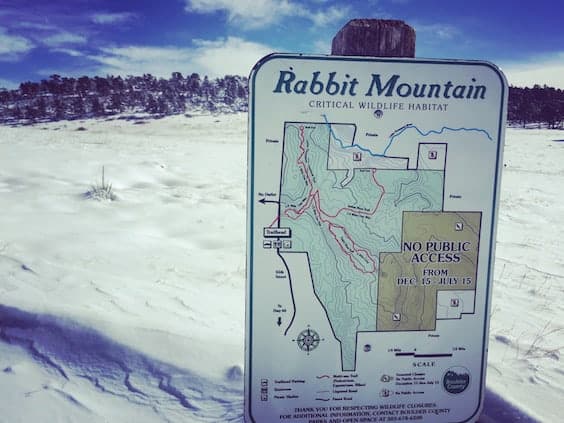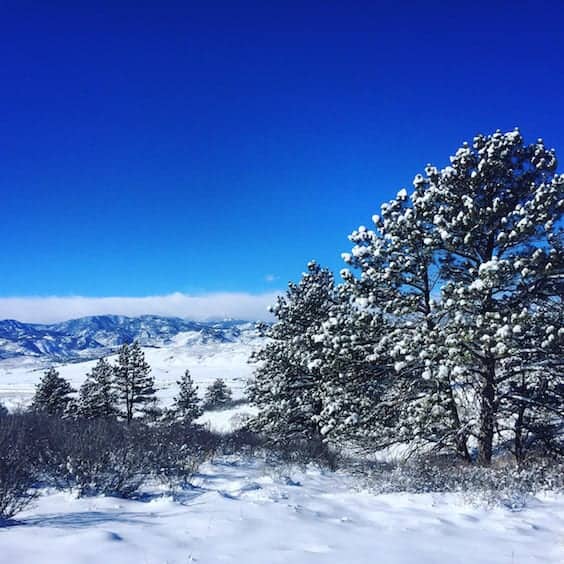
When Boulderites leave the bubble in search of new adventures, many of us automatically head west toward the towering peaks of the Rockies. But Boulder County is full of lesser-known adventures along the Front Range and even on the plains. While everyone else is inching their way up Boulder Canyon or crawling along I-70 to overflowing trailheads, you could be on an empty country road heading toward your own little piece of paradise.
Rabbit Mountain lies 18 miles northeast of Boulder between Lyons and Longmont. Although it’s more of a hill than a mountain (the summit clocks in at 6,006 feet), the area comprises 2,733 acres of open space and over 5 miles of multi-use trails. It’s the perfect size for a challenging run, an invigorating hike, or a freewheeling bike ride.
Its network of easy-to-moderate trails can be enjoyed year round. The landscape and surrounding views are surprisingly stunning. The plant and animal life is incredibly diverse. The cultural history dates back thousands of years. Most people who make the trek to Rabbit Mountain have only one question afterward: “Why haven’t I been here before?”
Get there
Rabbit Mountain is approximately 30 minutes northeast of Boulder. Take 36 N to CO-66 E. Turn right on CO-66 E and then turn left at N. 53rd Street. Follow the road (it soon turns into N. 55th) all the way to the trailhead.
The parking lot can accommodate 41 cars and 4 horse trailers. During the week, you’ll have it largely to yourself. On the weekends (especially with nice weather), it will be busier but it rarely fills up completely.
Dogs are permitted but must stay on-leash.
Hike it (or run it or bike it)
Rabbit Mountain was the Arapaho Indians’ winter home. Chief Niwot himself is rumored to have spent much of his time here. The wide variety of plants and animals provided ample food for these hunters and gatherers. The hillsides and rock formations provided a natural barrier from strong winter winds.
In the 19th century, homesteaders arrived in search of gold. Over the years, many turned to farming. The land ultimately became the property of Forest Ranger Jack Moomaw’s granddaughter. Wanting to preserve the beauty of the land, she sold it to Boulder County in 1984.
Rabbit Mountain continues to be preserved and maintained by Boulder County Parks and Open Space. The area includes trails for recreation as well as critical wildlife habitat and unique geological formations. The summit is closed seasonally to protect golden eagle nesting habitat, though this does not impact any of the trails. While exploring Rabbit Mountain, keep your eyes open for raptors, large herds of mule deer, prairie dogs, coyote, rattlesnakes, and, of course, rabbits. (Take extra care to avoid rattlesnakes in the warmer months… or limit your visits to wintertime when they are not present.)
The trails at Rabbit Mountain are such that you can create a short sprint or a longer meander. Eagle Wind is a popular 3-mile loop with spectacular views of Long’s Peak and Mount Meeker to the west, the Boulder range to the south, and the St. Vrain River Valley to the east. Eagle Wind takes you close to the critical habitat at the summit and wildlife sightings are all but guaranteed. With only 348 feet of elevation gain, it’s easy-going enough for most fitness levels. Fresh snow in the winter makes it more challenging and ideal for snowshoes.
To add 2 miles round trip and another 149 feet of elevation, tack on the Little Thompson Overlook Trail. This trail winds up and down to the rusty sandstone of the Little Thompson canyon. The rocky outcropping at the end (and a well-placed bench) is your reward. This is one of the most unique and visually striking vistas in Boulder County.
So next time you’re in search of new terrain, just say no to the line of cars heading west. Mix it up and head over to the unexpected beauty of Rabbit Mountain. Unspoiled views, quiet multi-use trails, and a myriad of wildlife make for a mini-adventure you’ll want to enjoy again and again. Happy trails, Boulderites!






